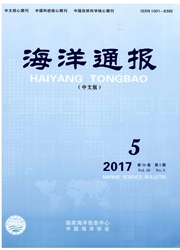

 中文摘要:
中文摘要:
提出了海表温度(SST)和海表盐度(SSS)可统一由混合层深度内对应的平均温、盐度作零阶近似的理论假设,据此利用Chu等提出的最大角度法构建混合层模型,并考虑障碍层和补偿层的影响,得到合成的混合层深度,从而实现了基于混合层模型反推SST和SSS。以太平洋海域为例,分别利用WOA13气候态(1-12月)资料、TAO逐年逐月资料以及历史船载CTD资料检验了这一假设。不同资料检验结果均表明,反推得到的SST、SSS与实测值相关性较高,两者之间残差也较小。将此方法应用于Argo剖面,反推出对应的SST和SSS,并利用逐步订正法对散点资料进行客观分析,生成2004年1月-2014年12月逐年逐月的1°×1°的网格化SST和SSS。对网格资料进行检验,结果发现由Argo反推的SST和SSS气候态分布特征与WOA13资料非常相似,差异不大;与TAO实测资料相关性较好,甚至略高于同类型网格资料与TAO资料的相关系数;EOF分析表明,无论是空间还是时间的主要变化模态,与同类型的网格资料符合性较好。综合来看,构建的混合层模型可以用于Argo表层温、盐度的反推,获得较高质量的SST和SSS,能较好弥补Argo缺乏表层资料的不足。
 英文摘要:
英文摘要:
Based on the assumption that SST and SSS can be unified by the averaged temperature and salinity at the depth of mixed layer, we construct a model of mixed layer to estimate the SST and SSS according to the information of the mixed layer in the ocean. This method uses the zero order approximation of the maximum angle method, which was proposed by Chu( 2011), and by considering the effect of barrier layer and compensation layer on the estimation accuracy, we get the composed mixed layer depth, so we can estimate both SST and SSS by the mixed layer model. Taking the Pacific Ocean as an example, we use the climatology WOA13 datasets(January ~ December), monthly and yearly TAO dataset and historical ship-based CTD data to examine this hypothesis. The estimated SSS and SST from the three different data sets correlate with each other very well and with small residue, which suggests the reliability of the method. We use this method for Argo profile data to construct the gridded SST and SSS with horizontal resolution of 1°×1° from January 2004 to December 2014 with the successive correction method. It is found that the constructed gridded Argo SST and SSS climatology distribution characteristics are consistent with those showed by WOA13 dataset, and the difference between them is very small. Besides,there is good correlation between Argo and TAO data, and that is slightly higher than the correlation coefficient between TAOand other Argo gridded data sets. EOF analysis shows that temporal and spatial variability between the main modes is similar.According to the successive application of this method in the three different observational datasets, we have confidence that this mixed layer model can be used to estimate SST and SSS from Argo profiling float observation very well, and it can compensate the shortcoming of the Argo data which are lack of surface SST and SSS data. The estimated SSS and SST data from this method can also provide an assessment data for remote sensing products.
 同期刊论文项目
同期刊论文项目
 同项目期刊论文
同项目期刊论文
 期刊信息
期刊信息
